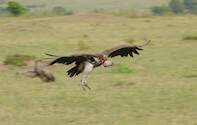
It's not far from Kimberley to Hoedspruit, as the vulture flies. That is, when you consider that a white-backed vulture tagged in Kimberley has turned up in Otjiwarongo in north-central Namibia, a distance in excess of 1200km - as the vulture flies.
It was recently decided by people involved in the conservation of birds of prey that the traditionally used method of placing rings on birds' legs as means of identifying individuals could be supplemented by the use of cattle tags inserted into a flap of skin on the bird's right forewing where there are no blood vessels or nerves.
Although previously used by researchers involved in specific projects many decades ago, these patagial tags will now be used to mark all raptors that would normally have only been fitted with leg rings. Their use is already paying dividends despite the fact that relatively few birds have been fitted with the tags so far, and excited conservationists are spotting marked birds in surprising places.
The staff at Moholoholo Rehabilitation Centre in Hoedspruit were amongst the delighted conservationists this June when they trained their binoculars on the vulture restaurant at the centre and found a whitebacked vulture with a blue wing tag amongst the squabbling hordes. A spot of research together with the Endangered Wildlife Trust (EWT) showed that the bird had originally been tagged in Kimberley, and had travelled an absolute minimum of 800km before arriving in Hoedspruit.
The Moholoholo staff have a special interest in birds fitted with patagial tags, as they released 17 tagged vultures last year that they had nursed back to health after a mass vulture poisoning incident. They have kept an eye out for their yellow tags ever since, as the birds were 'test piloting' the use of the tags in the wild. "Only three have not been recorded as a re-sighting from the 17 poisoned birds" says Corrie van Wyk from Moholoholo.
The Hoedspruit sighting of a vulture tagged in Kimberley was swiftly followed by the even more impressive re-sighting of another Kimberley bird by researchers in Namibia. However, Moholoholo also has its own international visitors - two marabou storks have recently turned up at the vulture restaurant bearing red tags that were fitted in Swaziland.

These re-sightings of tagged birds mark a major step forward for raptor researchers. The EWT's Birds of Prey Working Group manager Andre Botha says that over the last 50 years more than 7,000 vultures were ringed, but less than 10 percent of these birds were ever re-sighted either dead or alive.
With so few tagged birds being spotted so often, the new method will reveal much more about how far vultures and other birds of prey travel in their daily lives. All the data gathered on bird re-sightings is fed into a database kept by the South African Bird Ringing Unit (Safring) of the Avian Demography Unit at the University of Cape Town.
According to Safring, "The database as a whole is a resource which may be used by researchers, conservation biologists and managers, and primarily provides answers to questions related to movement and survival. Research into bird populations of importance to fisheries, agriculture, conservation and water management authorities involves bird ringing. Ringing provides a cost-effective tool for monitoring our environment and commonly draws attention to pollution, poisoning, powerline incidents, longline fishing fatalities and other hazards."
Meanwhile, Brian Jones, manager of Moholoholo, is hoping to carry out a mass capture exercise on vultures in the near future. He says that he hopes to fit two patagial tags to each of the birds, and then mount a photographic competition that focuses on roosting birds. Having dealt with many hundreds of poisoned vultures over the years, he is hoping to find out more about the breeding success of vultures, especially if are recovered victims of a poisoning incident.
By Melissa Wray

